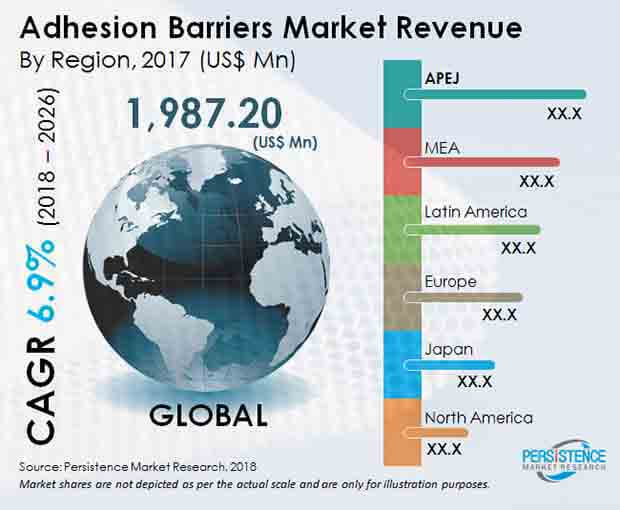Adhesion Barriers Market Segmented By Fibrin Based, Collagen Based Natural Adhesion Barriers and Synthetic Adhesion Barriers in Gel, Liquid, Film Formulations for Abdominal Surgery, Gynecological Surgery, Orthopedic Surgery, Cardiovascular Surgery, Reconstructive Surgery, Urological Surgery
Industry: Healthcare
Published Date: August-2018
Format: PPT*, PDF, EXCEL
Delivery Timelines: Contact Sales
Number of Pages: 286
Report ID: PMRREP3202
An adhesion barrier is used to reduce abnormal internal scarring following surgery by separating the internal tissues and organs. Adhesion barriers are used in the abdominal, gynecological, orthopedic, cardiovascular, reconstructive, and urological surgeries.
Adhesion barriers are mostly used in cardiovascular surgeries to heal the coronary artery. The gel and film formulations of adhesion barriers are widely used as compared to the liquid formulation. The application of adhesion barriers is increasing with the increasing number of surgical procedures.
The adhesion barriers in gel form are sterile, transparent and highly viscous, they act as a barrier to prevent or reduce post-surgical adhesions at the surgical site. Hyalobarrier gel (Anika Therapeutics) is one of the examples of commercially available gel formulation. The liquid form of adhesion barrier is generally made of high molecular glucose polymers, such as Icodextrin, which prevent the internal tissue surfaces and the organ from adhering to each other during and post-surgery.
The commercially available adhesion barriers in liquid form are Adept (Baxter International Inc.) and Bio-Gide Perio (Geistlich Pharma Inc.). Adept acts as an anti-adhesion by hydroflotation. The film form of adhesion barrier is made of biodegradable materials such as collagen and gelatin. Some of the commercially available film formulations are GYNECARE INTERCEED (Johnson & Johnson (Ethicon Inc.), Seprafilm (Sanofi), and Epifilm (Anika Therapeutics), they are used based on the application.
Use of adhesion barriers is an effective way to reduce or prevent the incidence, severity, extent and consequences of post-surgical adhesions, as there are no other drugs available for prevention of surgical adhesion. Adhesive barriers are the only exclusive solution for post-surgical adhesions, which is expected to drive the demand for adhesion barriers over the forecast period.
Likewise, increasing demand for and availability of adhesion barriers for use in abdominal, gynecological, orthopedic, cardiovascular, reconstructive, and urological surgeries are expected to create enormous growth opportunities for the manufacturers operating in the adhesion barriers market.
The global adhesion barriers market estimated to be worth US$ 2,111.1 Mn by 2018 end and is expected to expand at a CAGR of 6.9 % over the forecast period of 2018–2026. North America accounted a large share in the global adhesion barriers market and was valued at US$ 655.3 Mn in 2017, and is expected to expand at a CAGR of 6.3% over the forecast period. By product type, the natural adhesion barriers segment is expected to hold a large share of 50.7% in the global market for adhesion barriers in 2018 and grow at a CAGR of 7.2% over the forecast period.
The growth of the global adhesion barriers market is primarily driven by growing adoption of adhesion barriers with increasing number of surgeries (particularly cardiovascular surgeries) and focus of the key players on lowering the cost of the products. Besides, increasing number of cardiovascular interventions such as coronary revascularization, valvular repair procedures, coronary artery bypass graft surgery (CABG) is also expected to drive the growth of the adhesion barriers market.
The growing awareness regarding use of adhesion barriers post-surgery in developing countries is expected to drive the demand for adhesion barriers and consequently contribute to the growth of the global adhesion barriers market over the forecast period. However, limited applications of few of the product types of adhesion barriers and high cost of surgeries are some of the factors expected to hamper the growth of the global adhesion barriers market over the forecast period.

Geographically, North America is expected to be the dominant regional market for adhesion barriers by 2018 end and is expected to expand at a CAGR of 6.3% over the forecast period due to developed medical infrastructure and favorable reimbursements for adhesion barriers. Asia-Pacific is expected to be the fast-growing regional market for adhesion barriers in terms of revenue in the global adhesion barriers market, registering a CAGR of 7.7% over the forecast period as the countries of Asia- Pacific, such as India, Malaysia, Indonesia and Mexico, are witnessing spur in FDI (Foreign direct investment) and they have outstripped the economic growth compared to developed regions. These factors are have increased the investment across the healthcare sector in these countries, which as a result is expected to boost the growth of the market for adhesion barriers over the forecast period.
The Middle East and Africa is expected to grow at a 7.4% CAGR in the global adhesion barrier market over the forecast period with share of 2.9% in 2018. In the Middle East and Africa, the GCC Countries is expected to hold a major share of 41.5% in 2018 and grow at a CAGR of 7.1% over the forecast period.
Examples of some key players operating in the global adhesion barriers market are Baxter, Johnson & Johnson (Ethicon Inc.), Anika Therapeutics, Inc., Sanofi, FzioMed, Inc., Betatech Medical, Integra LifeSciences Corporation, Tissuemed Ltd., Hangzhou Singclean Medical Products Co., Ltd., and Symatese.
| Attribute | Details |
|---|---|
|
Product Type |
|
|
Form |
|
|
Application |
|
|
End User |
|
|
Region |
|
To know more about delivery timeline for this report Contact Sales
